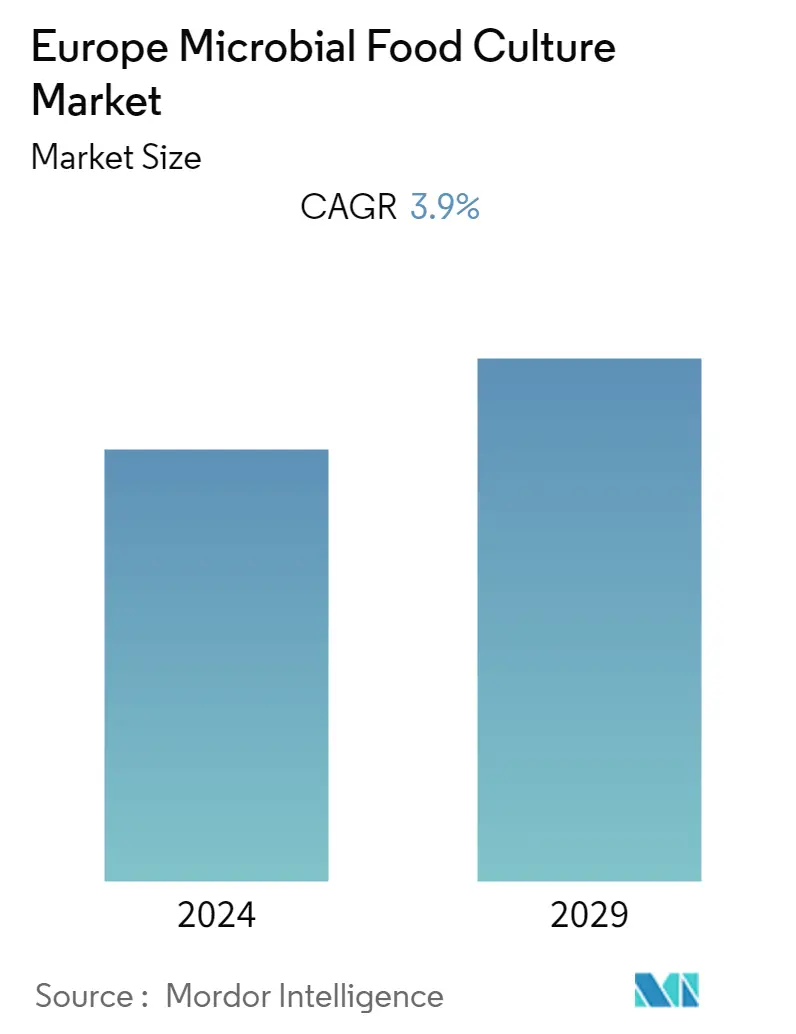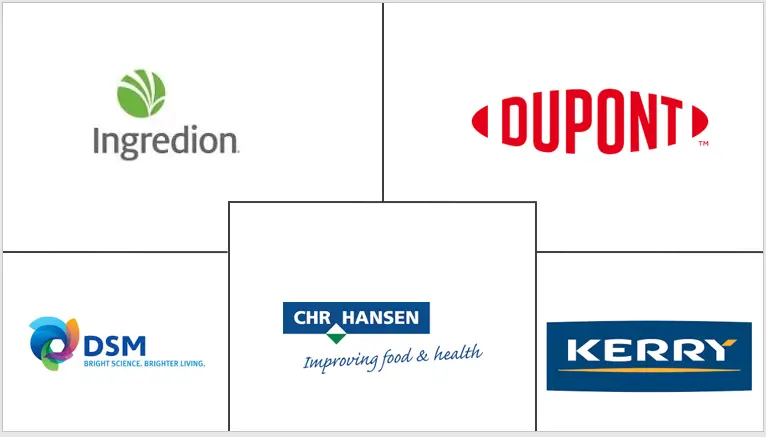Market Size of Europe Microbial Food Culture Industry

| Study Period | 2019 - 2029 |
| Base Year For Estimation | 2023 |
| Forecast Data Period | 2024 - 2029 |
| Historical Data Period | 2019 - 2022 |
| CAGR | 3.90 % |
| Market Concentration | Low |
Major Players
*Disclaimer: Major Players sorted in no particular order |
Europe Microbial Food Culture Market Analysis
Europe Microbial Food Culture Market is projected to grow at a CAGR of 3.9% during the forecast period 2020-2025.
- The microbial culture market is witnessing growth with the increasing demand for probiotic and fermented food and beverages, such as kefir, kombucha, and kvass, and the food and beverage manufacturers seeking innovative ingredients to enhance the shelf life of their products to meet the changing consumer needs
- Microbial culture is also gaining attraction from the manufacturers due to the growing acceptance of the bio-preservation concept. Bio-preservation is an attractive alternative to chemical and physical preservation. Food fermentations offer excellent models for studying the basic principles and mechanisms of bio-preservation, and traditional fermentations may be valuable resources of new strains for bio-preservation.
Europe Microbial Food Culture Industry Segmentation
Europe Microbial Food Culture Market is segmented by product type, end-user industry, and geography. Based on product type, the market is segmented into Starter Cultures, Adjunct and Aroma Cultures, Probiotics. On the basis of the end-user industry, the market is segmented into Bakery and Confectionery, Dairy, Fruits and Vegetables, Beverages, Other End-user Industries,. Based on geography, the report provides a detailed regional analysis, which includes Germany, France, Italy, Spain, United Kingdom, Russia, rest of Europe.
| By Product Type | |
| Starter Cultures | |
| Adjunct and Aroma Cultures | |
| Probiotics |
| By End-user Industry | |
| Bakery and Confectionery | |
| Dairy | |
| Fruits and Vegetables | |
| Beverages | |
| Other End-user Industries |
| By Geography | |
| Germany | |
| United Kingdom | |
| France | |
| Spain | |
| Italy | |
| Russia | |
| Rest of Europe |
Europe Microbial Food Culture Market Size Summary
The European microbial food culture market is experiencing a notable expansion, driven by the rising consumer demand for probiotic and fermented foods and beverages like kefir, kombucha, and kvass. This growth is further fueled by food and beverage manufacturers' pursuit of innovative ingredients to extend product shelf life and adapt to evolving consumer preferences. The concept of bio-preservation is gaining traction as a viable alternative to traditional chemical and physical preservation methods, with food fermentations providing valuable insights and resources for new bio-preservation strains. The food processing industry is benefiting from the introduction of new fermented products, catering to the increasing consumer desire for product differentiation and the advantages of prolonged shelf life.
Germany stands out in the European microbial culture market due to its advanced food processing sector, which supports the organic growth of products, particularly in dairy. The market is characterized by intense competition, with numerous local and international players contributing to its fragmented nature. Key industry participants, such as Chr. Hansen A/S, DuPont, Koninklijke DSM N.V., and Kerry Group, are focusing on product innovation to strengthen their market presence and diversify their brand portfolios. The introduction of specialized cultures, like Chr. Hansen's NEER‚Ñ¢ yeast for low alcohol beer, exemplifies the industry's commitment to meeting the demand for healthier and flavorful alternatives to traditional alcoholic beverages.
Europe Microbial Food Culture Market Size - Table of Contents
-
1. MARKET DYNAMICS
-
1.1 Market Drivers
-
1.2 Market Restraints
-
1.3 Porter's Five Forces Analysis
-
1.3.1 Threat of New Entrants
-
1.3.2 Bargaining Power of Buyers/Consumers
-
1.3.3 Bargaining Power of Suppliers
-
1.3.4 Threat of Substitute Products
-
1.3.5 Intensity of Competitive Rivalry
-
-
-
2. MARKET SEGMENTATION
-
2.1 By Product Type
-
2.1.1 Starter Cultures
-
2.1.2 Adjunct and Aroma Cultures
-
2.1.3 Probiotics
-
-
2.2 By End-user Industry
-
2.2.1 Bakery and Confectionery
-
2.2.2 Dairy
-
2.2.3 Fruits and Vegetables
-
2.2.4 Beverages
-
2.2.5 Other End-user Industries
-
-
2.3 By Geography
-
2.3.1 Germany
-
2.3.2 United Kingdom
-
2.3.3 France
-
2.3.4 Spain
-
2.3.5 Italy
-
2.3.6 Russia
-
2.3.7 Rest of Europe
-
-
Europe Microbial Food Culture Market Size FAQs
What is the current Europe Microbial Food Culture Market size?
The Europe Microbial Food Culture Market is projected to register a CAGR of 3.9% during the forecast period (2024-2029)
Who are the key players in Europe Microbial Food Culture Market?
Kerry Group, Chr. Hansen, DuPont De Numors Inc. and Koninklijke DSM NV are the major companies operating in the Europe Microbial Food Culture Market.

